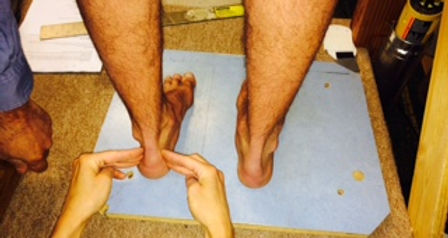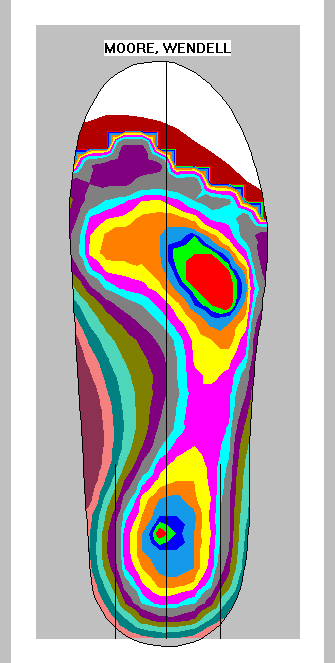
Better Balance.ca
Structural Alignment Screen
The ski boot is said to be the most important part of your ski equipment. The alignment of your boots to the skis and by extension to your leg structure is equally as important if you want to ski well and enjoy the rewards of proper bio-mechanics at play.
The SAS Process differentiates itself from conventional alignment solutions by performing both an in-shop static, and an on-hill dynamic alignment verification; with the goal of attaining maximum performance for technical advancement. Without these two components, it is pure coincidence that a skier attains proper alignment.
A 10 Second Test: Compare how I am balanced in the photo and how the balance point differs with the random skier who just happened to be skiing by. Notice how I am balanced on the centre of my ski while the random skier is balanced on the inner edge[s] of both of his skis.
Visualize yourself balancing in both positions and then determine which one would be optimal to give you controlled instant access to a directional change. Try both stances at home in your living room.
Skier Testimonial
Hello Wendell,
I would like to thank you very much for helping me to solve a problem with my knee and hip pain while skiing.
I had this pain for the last 5 years. I tried to find any solution for the pain, talked to doctor, chiropractor, physio therapist with no positive results. I am so glad I talked to you, Wendell, about the pain and you suggested to make an alignment on my ski boots.
After your alignment, I feel like a new man on the skis. I can make short turn with ease, balance on one ski and most of all, having fun skiing without the pain.
I will recommend to anyone with a sore knees or hips to see Wendell. Skiing should be an enjoyable activity for the years to come.
Thanks again.
Daniel Martinez
How and why did the SAS come about?

The SAS Process started in 2011 as part of the Senior Ski Team Tech Camps on Whistler/Blackcomb. Today, we are proud to offer an evolved version of the Structural Alignment Screen [SAS] to the general public complete with a new name, "Better Balance Process."
The Genesis of the Better Balance Process is the Harb Ski System. Over the past 20 years, Harald & Diana have fitted and successfully aligned over 10,000 skiers from beginners to racers . Simply put, they have identifed the alignment process as the key that opens the door to achieving ski performance and technical advancement.
Because the majority of skiers require alignment adjustment’s, the Better Balance Process is designed to do just that, ensure the skier is properly balanced on their skis, able to execute the movements that puts the ski on edge or at an angle to the snow. The movements start with the feet and affect the kinetic chain up to the torso.
Since your feet and ankles are totally wrapped by the ski boots, they are the most important piece of your ski equipment, rarely however are they ready to ski right out of the box. In addition, none of us have equally functional feet and legs for skiing and everyone has different foot and leg structures. Getting fitted with the correct ski boot can often be a daunting task.
Ski boots couldn’t possibly be ideal for all of us. There are some compromises and assumptions in boot design and for many skiers, these have a dramatic effect on their skiing performance, ability to improve, and ultimately, enjoyment of the sport.
Today there are very few ski shops that understand the link between ski boots, alignment and ski performance. In addition ski instructors are not taught how to evaluate dynamic alignment on the hill and how alignment affects the movements required to ski on modern skis. And, to make the diagnosis of alignment problems even more difficult, North American ski instruction does not teach edge release to the transition using foot movements – which is what proper alignment is about.
Compelling Thoughts

It has become obvious to us that skiers of all abilities need to pay attention to how their feet are aligned to their skis and boots.
Initially, when corrections are made, the skier gains bio-mechanical advantage, which in turn, captures the maximum leverage afforded from their equipment.
Ultimately, the process assures the skier long term optimal use of the ankle, knee and hip joints. Misaligned joints subjected to the rigours of skiing over time will cause discomfort, pain, even injury; joints are further compromised when a boot is too loose, or the boot shell is too high.
For the vast majority of skiers the Better Balance Process is like a journey in ski performance discovery. You are going to be introduced to your own intimate bio-mechanics and learn a whole new language!
According to Harald Harb, alignment of your leg, foot and knee tracking for skiing, isn't just a passing fad. An incomplete or poor set up, could mean injury, and knee problems as severe as an ACL injury.
The Harb Ski System has been leading the way in measurement and study of alignment data for decades.
If you look like the skier in this photo on any ski, but especially on a ski 80mm wide, under foot, or wider, you need to get aligned as this is an extremely weak position and your ACL is in danger! Plus, properly aligned, you will ski with more ease and less leg fatigue.
Some off-set ski boots like some of the Fischer and the Nordica models that have been promoted, made this worse by setting the foot's first ray, (big toe) more toward the middle of the ski width. Poor boot fitting, such as "wide lasts", also contributed greatly to this issue. Get checked by a specialist in this field, it's worth every dime. Harald Harb
Motivators

The entire skier population is aging and aging joints need all the leverage they can muster. Topping that, the average skier is carrying a few extra pounds down the slopes which alone, places even more stress on the joints making alignment all the more imperative.
WHAT SHOULD MOTIVATE YOU TO TAKE THE SAS?
-
You may have recently purchased new equipment but recognize that something is still wrong with your setup
-
Your equipment is showing its age and you want to replace it and get it right this time
-
You suspect that there is some structural mis-alignment in your legs/feet and want it corrected
-
You may have a fit but, the symptoms of mis-alignment still persist. You are one of those people who has gone through a ski boot fitting, or even through numerous fittings over many seasons, and have come to the realization that the process has only ended up with a series of compromises and you still can't buy a turn.

HOW THE BETTER BALANCE PROCESS DIFFERENTIATES
ITSELF FROM THE COMPETITION
DURING THE DYNAMIC MEASUREMENT PROCESS, WE IDENTIFY WHETHER YOUR CENTRE OF MASS [CM] LINES UP TO THE INSIDE OR OUTSIDE OF YOUR TIBIA.
The BETTER BALANCE PROCESS identifies and makes sure that the BOOT you have gets leveraged up to accommodate your dynamic leg structure to assure you optimal balance over the ski.
Image courtesy of SureFoot Whistler
This is the image of my right foot as scanned by the foot pressure reader at SureFoot with the thin black centre line indicating the centre line of my foot. The red area in the forefoot of the image would suggest that I am bowlegged, simply by judging on which side of the centre line my CM resides.
What the static analysis cannot show is that I am actually knock kneed on this side, that is, my CM actually resides to the inside of the centre line when the dynamics of my leg structure are taken into account. On the right side, I have something called tibial torque that turns my tibia to the inside as I flex and actually twists my forefoot to the outside; the picture you see here.
For someone like myself, the on-snow dynamic assessment will contradict the static in-shop alignment analysis and will require a "tweak" to make it feel right and allow me to balance over the ski.
Our process will validate the "tweaking" you'll require to have solid dynamic balancing.
There you have it; for even more validation, here is a link to Harald's March 17, 2015 Blog entry on how important this process is to even racers and ski instructors.